Profile
Aisling Ryan
My CV
-
Education:
Secondary school: Coláiste Íosagáin, Dublin, Ireland,
Undergraduate degree: Trinity College Dublin, Ireland,
Postgraduate degree: RCSI (still here!), Dublin, Ireland -
Qualifications:
Junior Certificate (Irish equivalent to GCSEs),
Leaving Certificate (Irish equivalent to A-levels),
Bachelors degree in medicinal chemistry,
Currently finishing a PhD in inorganic medicinal chemistry.
(Medicinal chemistry is the application of chemistry to medicine, which is designing medicines to treat diseases!) -
Work History:
I have had lots of different jobs:
I was a babysitter all through my teenage years (age 14 – 19),
I have given grinds (private tutor) for the past six years in (At first teaching Irish for all school levels and more recently teaching chemistry for university level),
I worked in the jewellery shop Pandora during my holidays while I was in uni,
I have also worked in two different chemistry research labs whilst at uni 🙂 -
Current Job:
I am currently in the final year of a PhD in inorganic medicinal chemistry (making treatments for cancer).
My PhD is funded by the Irish Research Council (IRC) and associated with the SFI Research Centre for Pharmaceuticals (SSPC). I am also an associate member of the Royal Society of Chemistry (AMRSC).
-
About Me:
My name is Aisling (pronounced ash-ling, I’m Irish!) I live in Dublin and am currently finishing my PhD in chemistry. I love nature and the outdoors, especially bringing my two dogs for walks and taking photos of the sky at sunset!
-
Read more
I live in Dublin and have two cats and two dogs. I love to bring my dogs for walks everyday! I love taking simple photos of the sky with my phone camera, especially during a colourful sunset. Although I don’t play the piano I love to listen to piano music. My favourite is any song by Ludovico Einaudi!
-
Read more
I am a chemist and I work in a laboratory. In the lab I have all kinds of different flasks and beakers that I use to hold chemicals. I will plan which chemicals I could mix together to make a new medicine and what method I could use (just like when you are baking a cake at home!). I need to think about what temperature to use, how I will add the chemicals together, if any solid chemicals need to be fully dissolved etc. Once I am happy with a method and which chemicals/ingredients I need to use I will go to the lab and setup my reaction (like adding all of my ingredients into a bowl and mixing them). Sometimes it will take an entire day for my reaction to be finished (like keeping a cake in the oven for a day to cook)! I need to leave it turned on (reacting) overnight because it takes a long time for the medicine to form. The next day I return to the lab and see if my reaction has been successful. If my reaction worked I can then mix my new medicine with cancer cells.
For this I need to go to a different laboratory that is for biology. I can add my medicine to a dish that has some cancer cells in it. Then I leave the cancer cells and medicine for a few days. After a few days I will check the cancer cells, and if they have died it means that my drug was successful! More tests can be done by other scientists using the medicine I made to try and treat cancer in animals.
Most of the time it takes a while for me to find the correct method/recipe to make the medicine. Just like if you bake a cake and it gets burnt, or it doesn’t taste nice, or doesn’t rise- I need to go back and make it again until it is perfect!
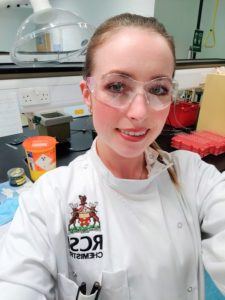
This is me in my lab wearing my lab coat and safety glasses. I wear my hair back so it doesn’t get in the way.
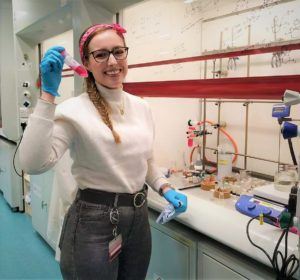
This is me in my chemistry lab holding some medicine I made (it is pink and it matches my hairband!) I am about to take this medicine to the biology lab to mix it with some cancer cells and see if it will cure the cancer. Before I go to the biology lab I need to heat the medicine so that it is the same temperature as our body! Do you know what body temperature is?
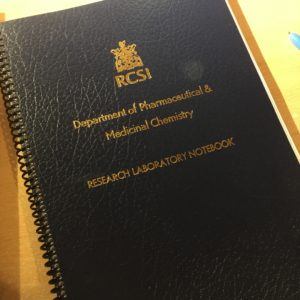
This is my laboratory notebook that I write all of my notes for my lab work and reactions in.
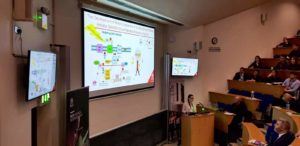
This is me presenting my research at a conference. I go to about 3 – 6 conferences a year and will either present my work like this with a powerpoint presentation, or else on a really big poster!
-
My Typical Day:
I read about work that other scientists have done to make medicine which helps me to decide which recipe/method and ingredients/chemicals I need to use. I then put on my lab coat and safety glasses and I go to my lab and add chemicals together to make some medicine.
-
Read more
I go to my office at the same time you go to school each morning. When I get to my desk I usually chat to my friends and read any emails I have. I will then plan my lab work. This involves either reading about how other chemists have made medicines similar to what I want to make (just like if you wanted to invent a new cake flavour you would look at the recipes and methods of other cakes to get an idea of how to do it!). Then I will use pen and paper to write out my method and what chemicals I plan to use. If I need to find a chemical I use a special computer in my lab that is like a library system. I just type the name of the chemical I want to use and the computer will tell me which press I need to look in. I will then get all of my chemicals ready and I will mix them toegther using the method I chose in my office. Like baking a cake, my chemicals take a while to react. Often I will leave the chemicals mixing overnight when I will go home in the evening time. The next day I can collect the medicine and I can use machines to analyse it. The machines can tell me if the powder I made is really the medicine I wanted to make. If the medicine is not correct I need to find a different method, or different chemicals and start again! Sometimes the medicines can look very nice- they can be lots of different colours and sometimes they appear as beautiful crystals!
I’ve tried my best to give you a tour of my lab and my lab work in the pictures below- if you have any questions about it don’t hesitate to ask me and I will answer ASAP! 🙂
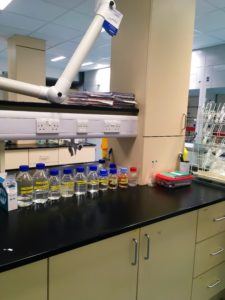
This is my work space in the lab. All of the bottles contain liquids I use for my reactions- I have a lot to choose from!
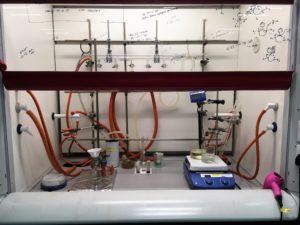
This is called a fume hood. It is where I leave my reactions to run because it is safe here. If something goes wrong the fume hood with keep in contained to this space. (But I am very careful that nothing goes wrong!)
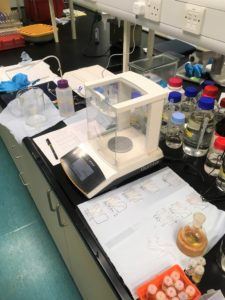
This is a balance I use to weigh chemicals- like you would use to weigh ingredients to bake a cake.
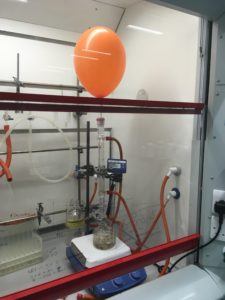
This is a reaction to make medicine. The long glass cylinder is called a condenser and the balloon is filled with nitrogen gas!
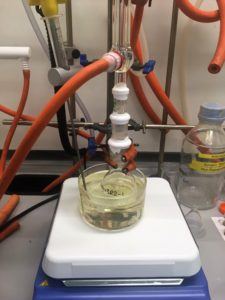
This is a reaction. The bath is filled with oil. I use the heating mantle (white surface) to heat the oil, which will heat the reaction. Like when you are cooking pasta. The hob heats the water in the pot and the water heats the pasta!
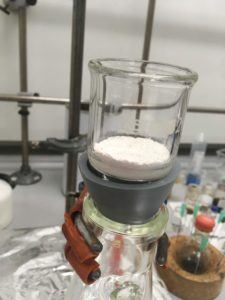
This is some medicine I made being filtered to remove any liquid (the top glass is a funnel with a filter, the white powder is the medicine.)
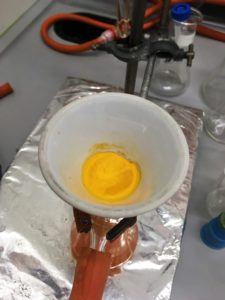
This is some orange powder that I made using chemicals. It is sitting in a special funnel. It is a medicine for cancer.
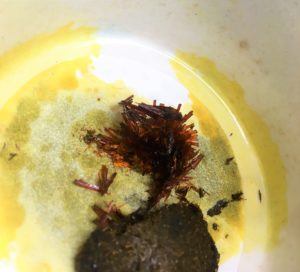
This is a medicine I made that forms crystals, it kills cancer cells!
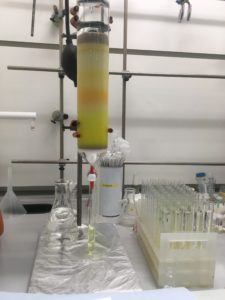
This is a purification technique I use called column chromatography. Liquid drips from the large column and I collect different fractions in the tubes to the right.
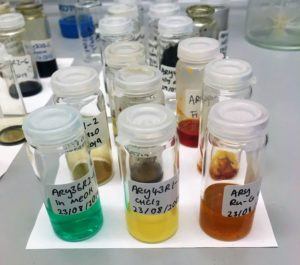
These are vials with solutions. Each one is a different colour; green, yellow, and orange!
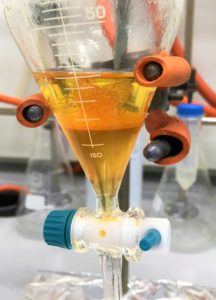
This is lab glassware called a separating funnel. There are two liquids in it that do not mix together. Both of the liquids are orange. The liquid on top contains some bubbles.
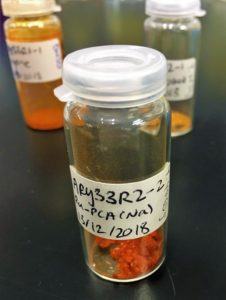
Here are some medicines I made in vials. The one at the front is orange crystals. I always label my vials with a code that tells me what is inside and I always include the date. I use the same code in my lab book for the notes I write about this medicine 🙂
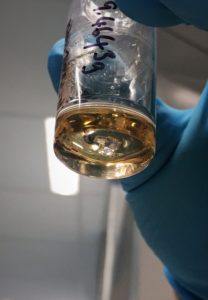
This is a vial with liquid and a large crystal has formed in the middle! Can you see it?
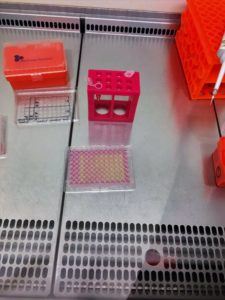
This is a dish containing cancer cells with medicine I made added in. It is in a special area that is very clean.
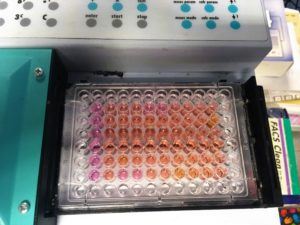
This is a machine I use to see if my medicine was able to kill cancer cells. The colour of the liquid tells me if my medicine worked! The pink liquid has live cancer cells and the yellow liquid has dead cancer cells.
-
My Interview
-
How would you describe yourself in 3 words?
Friendly, chatty, open-minded
What did you want to be after you left school?
A pharmacist
Were you ever in trouble at school?
I used to annoy some teachers because I never stop talking!
Who is your favourite singer or band?
Beyoncé and Westlife :)
What's your favourite food?
Pizza
If you had 3 wishes for yourself what would they be? - be honest!
1. That my dogs could live forever 2. That I could age more slowly 3. Everyone else in the world also got three wishes!
Tell us a joke.
Q: Why did the dinosaur cross the road? A: Because chickens hadn't evolved yet!
-
